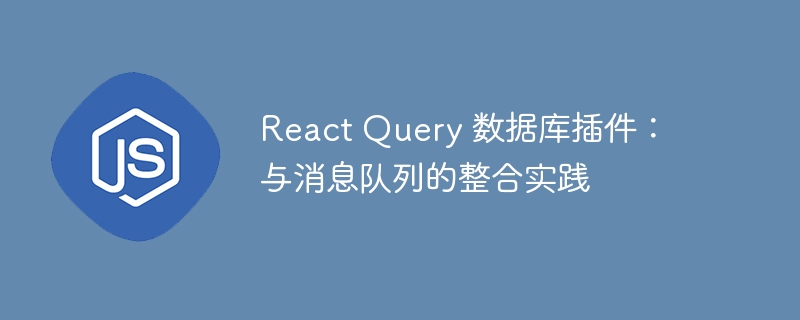Home >Web Front-end >JS Tutorial >React Query database plug-in: integration practice with message queue
React Query database plug-in: integration practice with message queue
- 王林Original
- 2023-09-29 11:05:111722browse

React Query Database Plug-in: Integration Practice with Message Queue
Introduction:
In modern web development, the interaction between the front end and the database is a very common requirement . As a powerful state management library, React Query not only provides a convenient data query and update mechanism, but also provides a plug-in system that can easily integrate various back-end technologies and data storage solutions. This article will introduce how to use the React Query database plug-in and combine it with the message queue to achieve more efficient data interaction.
1. Introduction to the React Query database plug-in
The React Query database plug-in is an open source library that extends the functions of React Query and provides a more convenient way for data addition, deletion, modification and query operations. The plug-in supports a variety of databases, such as MySQL, PostgreSQL, MongoDB, etc., and can also be customized to adapt to other databases.
2. Installation and configuration of React Query database plug-in
-
Installation
First, we need to install React Query and database plug-in in the project. The installation can be completed through npm or yarn. The following takes npm as an example:npm install react-query npm install react-query-db-plugin
-
Configuration
In the React Query configuration file, introduce and register the database plug-in:import { QueryClient, QueryClientProvider } from 'react-query'; import { createDBPlugin } from 'react-query-db-plugin'; //创建QueryClient const queryClient = new QueryClient(); //创建并注册数据库插件 const dbPlugin = createDBPlugin({ //数据库配置信息 host: 'localhost', port: 3306, username: 'root', password: 'password', database: 'my-database', }); queryClient.registerPlugin(dbPlugin); //将QueryClientProvider包裹在根组件外部 ReactDOM.render( <QueryClientProvider client={queryClient}> <App /> </QueryClientProvider>, document.getElementById('root') );
3. Use the React Query database plug-in to implement data interaction
Let’s take the MySQL database as an example to introduce how to use the React Query database plug-in to implement data addition, deletion, modification, and query operations.
-
Query data
In the React component, you can use theuseQuerymethod to query data. For example, we want to get a list of users from the database:import { useQuery } from 'react-query'; import { db } from 'react-query-db-plugin'; const UserList = () => { const { data, isLoading } = useQuery('userList', () => { return db.query('SELECT * FROM users'); }); if (isLoading) { return <div>Loading...</div>; } return ( <ul> {data.map(user => ( <li key={user.id}>{user.name}</li> ))} </ul> ); }; -
Create data
To create new data, you can use theuseMutationmethod. For example, we create a form to add a new user:import { useMutation } from 'react-query'; import { db } from 'react-query-db-plugin'; const AddUserForm = () => { const mutation = useMutation(values => { return db.query('INSERT INTO users SET ?', values); }); const handleSubmit = e => { e.preventDefault(); mutation.mutate({ name: e.target.elements.name.value, age: e.target.elements.age.value, }); }; return ( <form onSubmit={handleSubmit}> <input name="name" type="text" placeholder="Name" /> <input name="age" type="number" placeholder="Age" /> <button type="submit" disabled={mutation.isLoading}> {mutation.isLoading ? 'Loading...' : 'Add'} </button> </form> ); }; - The operations of updating data and deleting data are similar to creating data, and only need to use different SQL statements to achieve it.
4. Integration practice with message queue
In actual development, message queue is often used for asynchronous data processing. The integration practice of React Query database plug-in and message queue can be realized in the following ways:
-
Publish data change events
After the data addition, deletion, modification and query operations are completed, you can use the message queue to Data change events are sent out. For example, in the above example of creating data, you can publish an event after the data is inserted:const mutation = useMutation(values => { return db.query('INSERT INTO users SET ?', values) .then(() => { //发布事件 queue.publish('userAdded', values); }); }); -
Subscribe to data change events
Where you need to update the interface or other asynchronous operations, You can subscribe to the corresponding data change events and perform corresponding processing. For example, we want to update the interface when the user list changes:import { useQuery, useQueryClient } from 'react-query'; import { db } from 'react-query-db-plugin'; import { queue } from 'react-query-message-queue'; const UserList = () => { const queryClient = useQueryClient(); const { data, isLoading } = useQuery('userList', () => { return db.query('SELECT * FROM users'); }); //订阅事件 useEffect(() => { const subscription = queue.subscribe('userAdded', payload => { queryClient.setQueryData('userList', oldData => { //在现有的用户列表数据之后添加新用户 return [...oldData, payload]; }); }); return () => { subscription.unsubscribe(); }; }, []); if (isLoading) { return <div>Loading...</div>; } return ( <ul> {data.map(user => ( <li key={user.id}>{user.name}</li> ))} </ul> ); };
5. Summary
By using the React Query database plug-in, we can easily perform database operations and combine messages Queues enable more efficient data interaction. This article introduces how to install and configure the React Query database plug-in, and how to use the plug-in to query, create, update, and delete data. In addition, we also introduced how to integrate React Query with message queues to achieve asynchronous data processing. I hope this article can help you understand and apply the React Query database plug-in more deeply.
The above is the detailed content of React Query database plug-in: integration practice with message queue. For more information, please follow other related articles on the PHP Chinese website!
Related articles
See more- Detailed explanation of beanstalkd message queue in php and sharing of classes
- Detailed explanation of PHP message queue
- React Query Database Plugin: Tips for Managing Complex Data Models
- React Query Database Plugin: A way to achieve data archiving and recovery
- How to use React Query database plugin for data validation and formatting?

